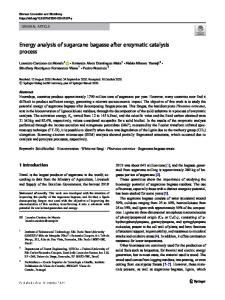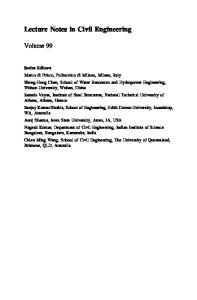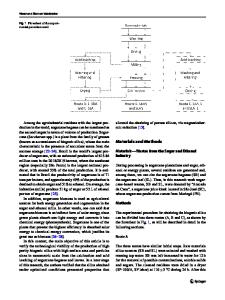Comparison of the adsorption capacity of acetaminophen on sugarcane bagasse and corn cob by dynamic simulation
- PDF / 1,808,263 Bytes
- 13 Pages / 595.276 x 790.866 pts Page_size
- 73 Downloads / 339 Views
RESEARCH
Sustainable Environment Research
Open Access
Comparison of the adsorption capacity of acetaminophen on sugarcane bagasse and corn cob by dynamic simulation Diego M. Juela
Abstract Acetaminophen (ACT), an antipyretic analgesic, is one of the emerging pollutants that has been found in high concentrations in domestic and hospital wastewaters. This study 7the adsorption capacity of sugarcane bagasse (SB) and corn cob (CC) for the ACT removal through the dynamic simulation of the adsorption column using Aspen Adsorption® V10. The effects of flow rate (1.5–3.0 mL min− 1), ACT initial concentration (40–80 mg L− 1), and bed height (20–35 cm) on the breakthrough curves were studied. Finally, the simulation results were validated with experimental studies, and analyzed by error functions, sum of squared errors (SSE), absolute average deviation (AAD), and coefficient of determination (R2). Based on the predicted breakthrough curves, ACT is adsorbed in greater quantity on CC, with saturation times and adsorption capacity greater than SB in all simulations. The maximum adsorption capacity was 0.47 and 0.32 mg g− 1 for CC and SB, respectively, under condition of flow rate of 1.5 mL min− 1, bed height of 25 cm, and ACT initial concentration of 80 mg L− 1. Breakthrough and saturation times were higher when the column operated at low flow rates, large bed height, and low ACT concentrations, for both adsorbents. The predicted and experimental breakthrough curves satisfactorily coincided with R2 values greater than 0.97, SSE and AAD values less than 5% and 0.2, respectively, for all studies. The experimental adsorption capacity was greater for CC than for SB, thus confirming that the software is able to predict which adsorbent may be more effective for ACT removal. The results of this study would speed up the search for effective materials to remove ACT from wastewaters. Keywords: Dynamic simulation, Aspen adsorption®, Sugarcane bagasse, Corn cob, Acetaminophen, Adsorption capacity
Introduction Pharmaceutical products are one of the emerging pollutants that have been of particular concern. In recent years, their presence has been detected in domestic and hospital wastewaters [1]. Pharmaceutical products are chemical compounds of complex structures of synthetic or natural origin, they contain active ingredients intended to counteract negative effects on the health of human and animals. These drugs end up in wastewater due to improper disposal of expired or unused drugs, Correspondence: [email protected] Department of Chemical Engineering, University of Cuenca, 010107 Cuenca, Ecuador
through urine and feces of patients and animals, leachate from soils, as well as domestic and hospital waste [2]. When these compounds reach the wastewater treatment plants (WTPs), there is no effective technology that can completely eliminate this type of pollutants, so their removal is only partial [3]. As a result of this, traces of these pollutants have been found in surface water, groundwater, and even in drinking water from va











